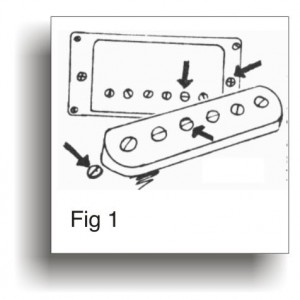PICK -UP ADJUSTMENTS:
It is important to have the pick-ups sitting properly under the strings for best sound and output. The trick is to adjust them so they are not too close and not too far away.
If the pick-up is too far away from the strings, it will have weak output or not much volume and tone.
If the pick-ups are too close, the strings may rattle against them. Or the magnets of the pick-ups may pull the string out of its natural orbit as it vibrates. This causes a funny out- of- tune sound. This is particularly true with very light gauge strings.
Adjusting the pick-ups up and down is a simple matter of turning the one or two set screws that sit on each side of the pick-up. (See Fig. #1)  Adjust them from 1/8th to 1/4 of an inch under the string. Be sure that after you have made the adjustment, you hold all the strings down on the last fret of the neck to see if you are hitting the pick-ups. If all looks good, play the instrument through an amp and check the output. Re-adjust as needed.
Adjust them from 1/8th to 1/4 of an inch under the string. Be sure that after you have made the adjustment, you hold all the strings down on the last fret of the neck to see if you are hitting the pick-ups. If all looks good, play the instrument through an amp and check the output. Re-adjust as needed.
On some pick-ups you will notice one or two individual set screws under each string. These allow you to adjust the output of each string separately. (See Fig. #1) This need only be done when you feel that an individual string is not coming through as loudly as the others. If this is the case, bring the set screw for that string up closer to the string. Or, if you feel one or more strings are too loud, lower the screws away from those strings. These adjustments should then balance the output of all the strings.
ELECTRONICS:
Crackles and Static: If you have a crackling of static sound when you turn your volume or tone controls or when you flip the switches, then these controls and switches need to be cleaned. A product (used in the electronics industry) called contact cleaner is used to clean these dirty controls. You can find this at places like Radio Shack.
To use, spray the noisy part, on the inside where the working parts are, and work the switch or pot back and forth for a minute or so. Let the part sit and dry for a few minutes and then plug in the guitar and see if it still makes noise. You may need to repeat the procedure several times. Even then you may find the part is beyond repair and needs to be replaced. Be advised that some contact cleaners may adversely affect the finish of the instrument, so take care not to let the contact cleaner onto the surface of your beautiful guitar.
If you are getting noise whenever you move your guitar cable, check it for shorts or dirty contacts.
Hums and Buzzes: There are many things that can cause humming through the electric system of your guitar. Things like room lighting and appliance transformers etc., can cause problems. If you are having these kinds of troubles, try moving to a different area of room. Set up your equipment the same and see if you still have the buzz. If the problem seems to be in the guitar or amp and not caused by outside influences, then have your local repairperson take a look for you.
This is the end of the electric guitar set up. Hope you have found this useful!
